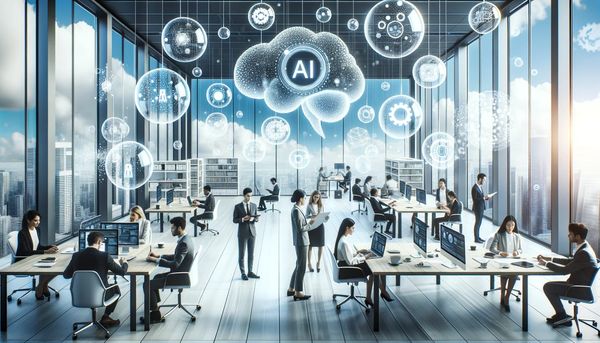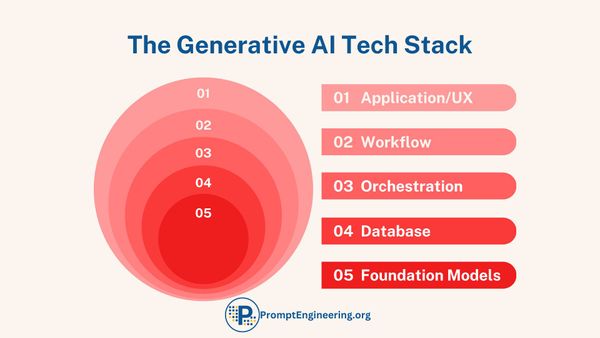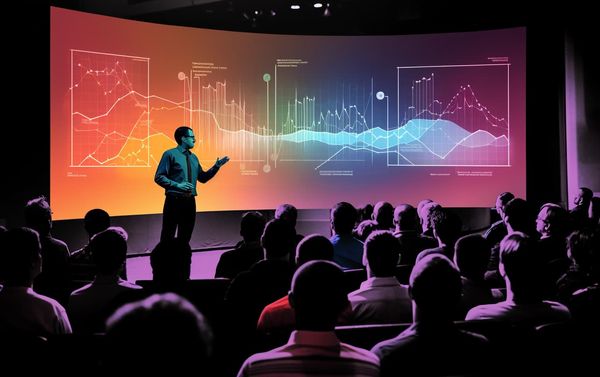Artificial intelligence (AI) is advancing rapidly, empowering machines to perform human-like tasks with increasing proficiency. As the field continues to evolve, two distinct branches of AI have emerged: traditional AI and generative AI. While both leverage complex algorithms and neural networks, their capabilities and use cases differ significantly.
Generative AI Creates, Traditional AI Analyzes
Generative AI refers to AI systems that can generate new content, such as text, images, audio, and video. The most popular current example is DALL-E 2, which can create photorealistic images based on text descriptions. Other common examples include tools like GPT-3 that can generate human-like text.
Traditional AI, on the other hand, focuses more on analyzing data to find patterns, categorize information, or make predictions. For example, computer vision algorithms can identify objects in images, while natural language processing systems can extract insights from text. Traditional AI underpins recommendations, predictions, classifications, and more.
What is Traditional AI?
Traditional artificial intelligence refers to AI systems that are programmed to perform specific tasks by following predefined rules and logic. Some of the key characteristics of traditional AI include:
- Programmed intelligence - Traditional AI relies on rules, logic, and algorithms crafted by human developers and computer scientists. The system performs tasks based on this programmed intelligence.
- Narrow applications - Traditional AI is narrow or weak AI, designed for specific use cases like playing chess, speech recognition, or recommending products. The systems cannot adapt beyond the original programming.
- Limited learning capabilities - While some traditional AI systems can improve over time through machine learning, their learning is limited in scope, relying on training data sets related to narrow tasks.
- No general intelligence - Traditional AI has no concept of generalized intelligence or sentience equivalent to humans. The systems focus on completing narrow, predefined tasks.
- Statistical analysis - To optimize performance, traditional AI often relies on statistical analysis of data sets and probabilities to detect patterns and make decisions based on previous programming.
- Analyzing data - Traditional AI focuses on analyzing data and making predictions based on that data. The algorithms process information and return expected results like analyses or forecasts.
- Predefined rules - Traditional AI solves specific tasks using predefined rules and logic outlined by developers. The systems follow this programmed intelligence.
- Useful for large data - Traditional AI is particularly useful when there is a large volume of data to analyze and underlying patterns or correlations to uncover. Its analytical approach shines here.
- High accuracy - Traditional AI delivers a high degree of accuracy and consistency for certain tasks like fraud detection that require precision in analysis.
Some common examples of traditional AI include chess-playing algorithms, chatbots, autonomous vehicles, fraud detection, and content recommendation systems. While powerful in their own right, traditional AI systems are designed for narrow purposes rather than general intelligence.
The Analytical Strengths of Traditional AI
Traditional AI focuses on analyzing data to detect patterns, make predictions, and optimize decisions. It relies on techniques like convolutional and recurrent neural networks, as well as reinforcement learning. Traditional AI excels at specific analytical tasks:
- Fraud detection - Using transaction data, traditional AI can identify anomalies and suspicious activities to prevent fraud. Its accuracy and consistency outperform humans.
- Predictive analytics - By finding correlations in data, traditional AI makes data-driven forecasts about future events and behaviours. This enables proactive planning.
- Data classification - Traditional AI can classify data points, images, texts, and other media with speed and precision. This automation brings efficiency gains.
- Automating routine tasks - Traditional AI can follow predefined programmatic rules to automate mundane, high-volume tasks in business and industrial settings.
In summary, traditional AI shines where analysis, accuracy, and consistency are paramount. It augments human capabilities through automation and insight.
The Analytical Applications of Traditional AI
With its capabilities in statistical analysis and pattern recognition, traditional AI lends itself well to a variety of analytical business and industrial applications.
- Fraud prevention - Banks and financial institutions analyze transaction data with traditional AI to identify anomalies, stop fraudulent activities, and reduce losses.
- Predictive analytics - Traditional AI systems can make data-driven forecasts about customer behaviours, demand, prices, equipment failures, and other business factors to inform planning.
- Data classification - Sorting customers into segments, identifying spam, and categorizing texts and images are all examples of classification tasks that traditional AI can automate.
- Process automation - Traditional AI excels at automating high-volume, repetitive back-office tasks to boost efficiency.
- Insights from big data - Traditional AI leverages machine learning to uncover correlations and transform massive datasets into actionable business insights.
- Natural language processing - Traditional AI can interpret text and speech to understand commands, questions, and sentiments.
- Autonomous vehicles - Self-driving cars rely on traditional AI for object recognition, route mapping, and real-time navigation.
- Predictive maintenance - By analyzing sensor data from machinery, traditional AI pinpoints potential failures before they occur.
The analytical strengths of traditional AI make it a strategic investment for data-rich industries like banking, insurance, logistics, healthcare, and more. It delivers the accuracy and reliability needed for impactful business insights.
What is Generative AI
Generative AI refers to a category of artificial intelligence focused on using neural networks to generate new, original content. Generative AI works by using machine learning models to generate novel content based on patterns learned from training data. Some key attributes include:
- Neural network generators - Generative AI uses neural networks like GANs and VAEs to generate images, text, audio, video, synthetic data, and other content from scratch.
- Generating from prompts - Generative AI starts with a text, image, video, design, or other input prompt that the system can process. Algorithms then return newly generated relevant content.
- Novel, original output - Instead of analyzing data, generative AI creates new data and media. The output is unique and original based on the initial prompt.
- Diverse applications - Uses span text, images, video, speech, music, game development, healthcare, and more. Possibilities are vast beyond basic content generation.
- Synthetic data capabilities - Sensitive data can be replicated through generative AI while preserving anonymity and compliance, like for healthcare.
- Limited reasoning - While skilled at creative tasks, most generative AI lacks contextual reasoning and judgment capabilities compared to humans.
Overall, generative AI removes human limits on imagination and productivity by automating customized, on-demand content creation. As the technology advances, managing its implications will be critical.
The Creative Applications of Generative AI
Unlike traditional AI, generative AI focuses on creating novel, original content. It utilizes techniques like generative adversarial networks (GANs) and variational autoencoders (VAEs) to generate images, text, audio, and other media. With the right training data and prompts, generative AI can produce output that is remarkably human-like. Key applications include:
- Creative media production - Generative AI can rapidly generate images, animations, music, and more to jumpstart graphic design and video projects.
- Synthetic data generation - Sensitive real-world data can be replicated through generative AI while preserving anonymity and compliance.
- Conversational agents - Smart chatbots that provide personalized recommendations and responses are powered by generative AI.
- Content creation - Full blog posts, product descriptions, abstract paintings, and even short novels can be computer-generated now.
- Data augmentation - Generative AI can create effective training data to improve image recognition, translation accuracy, and other AI systems.
In contrast to traditional AI's analytical approach, generative AI unleashes creativity, productivity, and customization. It opens the door for AI-powered invention across industries.
The Wide Application Range of Generative AI
Generative AI has diverse use cases across multiple industries thanks to its ability to automatically generate novel, customized content. Some major applications include:
- Marketing content creation - Generative AI can rapidly write product descriptions, website copy, social media posts, and other marketing content to save time and costs.
- Creative media production - For graphic design and video projects, generative AI can quickly generate images, animations, logos, music, voice-overs, and more to boost productivity.
- Drug discovery - By analyzing molecular data, generative AI can help discover new pharmaceuticals and optimize drug development pipelines.
- Software development - Generative AI can suggest code completions, simplify code, generate tests, and even fix bugs to significantly ease programming.
- Conversational agents - Smart chatbots rely on generative AI to provide personalized, natural responses to user queries and commands.
- Education - Generative AI can enhance educational materials by simplifying complex texts, generating missing segments in incomplete documents, and more.
- Entertainment - Original art, games, music, videos, and other media can be computer-generated now using generative AI.
The range of possibilities spans nearly every industry. As generative AI continues progressing, even more applications leveraging its creative power and customization will emerge. But care must be taken to ensure responsible and ethical implementation.
Combining Strengths for Innovation
While their approaches differ, generative and traditional AI each have distinct strengths that allow them to complement one another.
For instance, generative AI can rapidly create vast datasets of synthetic content. Traditional AI algorithms can then analyze these large datasets to find patterns for improving generative models. This technique of using generative AI to augment training data shows promise for fields like healthcare, where more high-quality data is needed.
Traditional AI is also critical for analyzing the creations of generative systems. By detecting biases, inaccuracies, or other issues, traditional AI can provide feedback to refine generative models. For example, offensive text generated by AI can be flagged by traditional algorithms, prompting adjustments to the generative models.
Applications combining both types of AI can lead to innovative new products and services. In autonomous vehicles, generative AI can create simulations to safely test edge cases, while traditional AI makes navigation decisions. For video games, generative AI creates new environments, and traditional AI analyzes player data to improve gameplay.
Applying Generative and Traditional AI Across Industries
In addition to the applications mentioned earlier, both generative and traditional AI are transforming a range of industries to drive innovation and solve complex problems.
In the automotive industry, autonomous vehicles rely heavily on traditional AI for object detection and decision-making. Generative AI can create synthetic sensor data for training as well as simulations for safe testing. Major automakers are investing heavily in AI to enable self-driving capabilities.
At large software companies, traditional code editors are being augmented with generative AI systems like GitHub Copilot that can suggest code as developers type. This assists programmers and speeds up development.
For content creation, generative AI is adept at synthesizing new images, videos, music, and text. Traditional AI then analyzes this content to detect patterns and biases that can improve the generative models. This combination enables more personalized, high-quality content.
In healthcare, traditional AI is being used to predict outcomes and analyze medical data. Generative AI can create synthetic patient data to better train models while protecting privacy. It can also generate realistic medical images to improve imaging diagnostics.
Across industries, the high computing demands of AI systems carries major energy consumption implications. As the use of AI grows, demand for electricity could surge globally. Ensuring AI is powered sustainably will require solutions like energy-efficient hardware and carbon-conscious model training.
For video games, generative AI shows promise for automatically creating environments, characters, and other game elements. Traditional AI can then analyze player data to tailor and enhance the gaming experience. This could reduce development costs and enable more dynamic, personalized games.
In manufacturing, generative AI can create novel product designs tailored to customer needs and production criteria. Traditional AI analyzes data on those designs and customer preferences to refine the generative models. This combination enables more customized, optimized manufacturing.
For marketing and advertising, generative AI is adept at creating persuasive, targeted copy and creatives. Meanwhile, traditional AI can analyze customer data to identify trends and micro-segments. This allows campaigns to be highly personalized and effective.
In healthcare, generative AI shows promise for synthesizing medical images that simulate disease progression over time. Traditional AI analyzes patient data to make predictive models for planning care. Together, they could significantly improve diagnostics and treatment.
Using generative AI, financial services firms can rapidly generate customized contracts and other documents based on templates and client data. Traditional AI reviews and extracts key data to validate contract accuracy and consistency. This can greatly streamline procurement and legal processes.
In gaming, generative models create fresh environments, characters, and storylines. Traditional AI evaluates player data to model engagement and optimize the gaming experience. This symbiosis enables more captivating, personalized games.
Across sectors, combining the creative capabilities of generative AI with the analytical strengths of traditional AI unlocks game-changing applications. As these technologies continue advancing, more industries will leverage them in tandem to solve problems in
Takeaway
Traditional AI and generative AI represent two distinct branches of artificial intelligence that take diverging approaches. Traditional AI focuses on analyzing data, detecting patterns, and making predictions. It relies on techniques like neural networks and reinforcement learning to excel at narrow analytical tasks requiring accuracy like fraud detection, forecasting, and data classification.
In contrast, generative AI uses neural networks to create novel, original content like images, text, audio, and video from scratch. It generates new data and media beginning from a prompt or training data. Generative AI has versatile creative applications across industries ranging from marketing content generation to drug discovery.
Promising the Future Through Collaboration
As artificial intelligence continues advancing rapidly, close collaboration between the generative and traditional branches of AI will open exciting new possibilities. With each approach complementing the strengths of the other, AI systems can become more capable, creative, and trustworthy.
Key will be developing frameworks for effective symbiosis between generative and traditional models. With thoughtful integration, AI can deliver even more substantial benefits - from accelerating scientific discoveries to democratizing content creation. The future looks bright for generative and traditional AI working together to push the boundaries of innovation.








